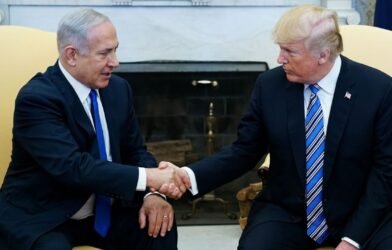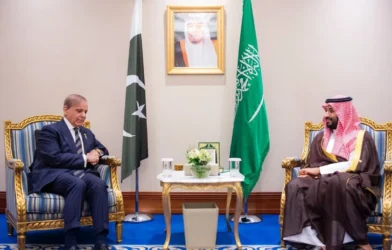Subtotal $0.00
Dr.. Dr. Mohamed Makram Balaawi
February 16, 2025
The world is witnessing a radical shift in the balance of power, as the unilateral American supremacy is declining in favor of the rise of China as an influential global power. This shift was not a spur of the moment, but rather the result of decades of economic policies, cautious political strategy, and rapid technological development that made Beijing a real competitor to Washington.
From Cooperation to Competition The Beginnings of China's Rise
US President Richard Nixon's meeting with Chinese leader Mao Zedong in the early 1970s marked a turning point in relations between the two countries. At that time, China was on bad terms with the Soviet Union and India, and was suffering from internal unrest and widespread famine, which prompted it to search for economic openness that would allow it to benefit from American technology and investment. On this basis, the United States began supplying production lines to China and providing aid to support the industrial and agricultural sectors, which opened the door to what became known as "socialism with Chinese characteristics," which the West saw as a form of "state capitalism."
With the collapse of the Soviet Union, it seemed to the United States that Chinese growth might get out of control, and that the goal on which its relationship with China was based - the dismantling of the communist camp - was no longer feasible, especially as the Chinese economy continued to grow significantly, and with the emergence of the United States as an unchallenged hegemon, the term "unipolarity" was introduced to reflect this new reality.
U.S. and Chinese Strategic Shifts
Despite growing US concern about the rise of China, US priorities in the post-Cold War era centered on the Middle East, where Washington fought several wars, most notably in Iraq and Afghanistan, which drained its resources and distracted it from Asian developments.
China's transformation into a global pole depends on internal and external balance and avoiding clashes with the West
On the other hand, China took advantage of this vacuum to strengthen its economic and military capabilities, taking advantage of the appetite of American and Western companies and capital to China, where it moved many factories and production lines, taking advantage of government facilities, low production costs represented primarily by cheap and trained Chinese labor, strong infrastructure, and the large Chinese market. In return, China also took advantage of its investments in US Treasury bonds and the US market being the first importer of its products.
With the advent of President Donald Trump, the US approach towards Asia in general, and China in particular, changed. Trump canceled several agreements that aimed to integrate China into the global system on US terms, and moved towards direct trade confrontation, and despite his imposition of high tariffs on Chinese products, this approach did not achieve the desired results, as China became less dependent on the US market and more capable of diversifying its exports.
"Belt and Road Expanding Chinese influence
The Belt and Road Initiative is China's most prominent tool to enhance its global influence. The initiative, which aims to revive the historic Silk Road through massive investments in infrastructure, provides China with political and economic influence in more than 140 countries, as China is no longer satisfied with developing its internal capabilities, but seeks to build a global economic network that makes it a key player in international trade.
The effects of this initiative have been evident in countries such as Pakistan, where China has funded the $62 billion China-Pakistan Economic Corridor project, turning the country into a major logistics hub. However, US pressure has prevented the implementation of some of its projects, such as the development of the Gwadar port, reflecting the growing conflict between the two powers over global influence.
Technology... China's secret weapon
In addition to economic power, China seeks to dominate future technological sectors through the "Made in China 2025" initiative, which aims to lead in areas such as artificial intelligence, semiconductors, and biotechnology. This strategy has alarmed the United States, which responded by imposing restrictions on the export of advanced technologies to Chinese companies, led by Huawei, and attempting to ban certain applications such as TikTok.
However, China is still ahead in some areas, such as having 40% of global AI patents, compared to only 22% for the U.S. It is estimated that the proportion of Chinese engineers working in AI exceeds 50% of global AI specialists, which was evident in the recent announcement of the DeepSeq AI program that led to the largest loss in the history of the U.S. stock market, which led to the largest loss in the history of the U.S. stock market.
The Global South, a support base for China's rise
China realizes that strengthening its influence is not limited to competition with the United States, but extends to building new alliances in the Global South. Through the BRICS organization, China seeks to reduce the dominance of the US dollar in global trade, as the percentage of trade exchanges between members of the organization in local currencies increased to 30%, compared to only 5% in 2015, and China presents itself as an alternative to the Western financial system, as its investments in developing countries reached more than $200 billion in 2023, making it a major partner for these countries in development and infrastructure.
The effects of China's rise on the Arab world depend primarily on the strength of its own states
In addition, it has worked to strengthen its presence in UN institutions, and in parallel launched a set of important initiatives in all fields, calling on the countries of the global South to interact with them, in light of the failure of the so-called rules-based global system, which was created after the Second World War, as it works selectively and largely ignores the interests of most countries of the global South.
Challenges and constraints to China's rise
Despite the successes achieved by China, it faces many challenges that may hinder its ambitions, most notably US pressures represented by economic sanctions, restrictions on the export of technology, and media campaigns aimed at questioning Beijing's policies, in addition to the challenge of economic interdependence, as the Chinese economy is based on interdependence with the West, despite China's efforts to diversify its markets, 40% of its exports still go to Western markets.
In addition to external challenges, there are also internal challenges. Low population growth rates, high domestic corporate debt, weak middle-class consumption, and empowerment of the hinterland are the main challenges that China is seeking to address.
Toward a New World Order
There is no doubt that the rise of China represents a radical shift in the international system, as it is no longer possible to talk about a unipolar world, especially in light of the continuous American failure to take into account the interests of the countries of the world and its adoption of a fierce policy that puts American interests at the center, far from any moral consideration in many cases. However, there are a set of questions that should be taken into account, namely:
Will China be able to transform into an international pole equivalent to the United States? Will this happen peacefully? Will the new order be more just? Will this be in the interest of the Arab world, or are we facing the replacement of hegemony with a new pole?
Although China's cultural and civilizational experience is radically different from the Western experience in general, and therefore Chinese behavior will not be a duplicate of the Western experience, the effects of this rise on the Arab world depend primarily on the Arab countries' own strength and their rise to the level of a competent partner for China, which requires these countries to prepare in proportion to the next stage.
China's transformation into a global pole depends on its ability to strike a delicate balance between its global aspirations and its internal challenges, and its desire to cooperate and avoid direct clashes with the West. In light of these changes, the world is about to enter a new phase of geopolitical competition that may redraw the maps of international influence for decades to come.









